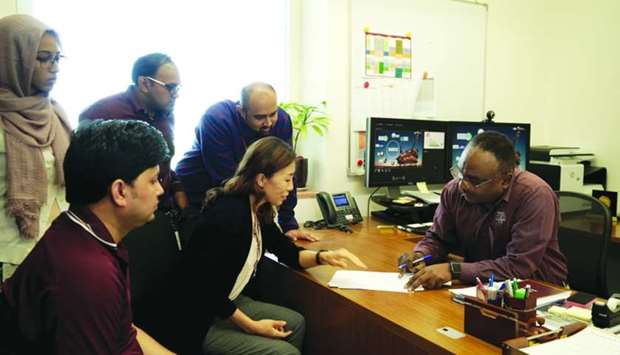A novel process developed by Texas A&M University at Qatar (Tamuq) researchers could help Qatar process its natural gas while reducing the country’s carbon footprint.
Developed in Qatar, CARbon-GENerator (Cargen) reactor technology was conceived and designed by Prof Nimir O Elbashir and his research team at Tamuq campus in collaboration with Prof Mahmoud M El-Halwagi and his co-worker Dr Debalina Sengupta from the Artie McFerrin Department of Chemical Engineering at the main campus in College Station, Texas.
This technology is believed to be the first of its kind that processes natural gas and captured carbon dioxide to produce both syngas, a valuable precursor to numerous hydrocarbon feedstocks that drive Qatar’s economy, and high-quality solid carbon nanotubes.
Elbashir’s research focuses on converting natural gas into valuable hydrocarbon products, including ultraclean fuels or useful chemicals, in a process called gas-to-liquid conversion, or GTL. A major drawback of GTL processing is that it produces a lot of CO2, which increases Qatar’s carbon footprint.
Elbashir and researchers at both campuses have focused on how to reduce CO2 emissions and reduce Qatar’s carbon footprint.
The Cargen technology was developed to advance the dry reforming of natural gas, which is especially attractive as it converts methane and CO2 through a reactor to produce syngas, a mixture of carbon monoxide and hydrogen that is then processed to make liquid hydrocarbons and ultraclean fuels.
This process, however, requires a lot of heat to drive the chemical reactions. This heat usually comes from burning fuels which emits even more CO2.
Elbashir’s team has designed the novel Cargen reactor, a second reactor added to the reforming process, along with a catalyst to drive the chemical reactions to produce expensive carbon nanotubes and syngas from CO2 and methane.
These high-quality carbon nanotubes can be used in several industries in Qatar, including steel and cement, while the syngas can be turned into ultra-clean fuels and value-added products. The process can be driven by either electric or solar power, eliminating the need to burn fuel and thereby resulting in much lower CO2 emissions than conventional technologies.
“We are making Qatar CO2 emissions into two products that are important to the economy in Qatar and will broaden the role of hydrocarbons in Qatar’s manufacturing facilities,” Elbashir said.
“CNTs are very expensive and extremely versatile, and can be used to manufacture products such as computers and other high-quality materials. And at the same time, we are also producing syngas, which can then be used to make the chemicals Qatar’s processing industries rely on.”
The Cargen reactor is a result of a nearly $5mn Exceptional Proposal grant from the Qatar National Research Fund’s National Priorities Research Programme, said PhD student Mohamed Sufiyan Challiwala, who has been a significant contributor to the project.
Dr Hanif Choudhury, a research scientist in Elbashir’s research group, said: “The Cargen concept of CNT generation has been validated at the micro-, milli- and gram scales, with the quality of the carbon nanotubes controlled and preserved at every scale.”
The next step is partnering with industry collaborators to scale up the technology further.
This technology is believed to be the first of its kind that processes natural gas and captured carbon dioxide to produce both syngas, a valuable precursor to numerous hydrocarbon feedstocks that drive Qatar’s economy, and high-quality solid carbon nanotubes.
Elbashir’s research focuses on converting natural gas into valuable hydrocarbon products, including ultraclean fuels or useful chemicals, in a process called gas-to-liquid conversion, or GTL. A major drawback of GTL processing is that it produces a lot of CO2, which increases Qatar’s carbon footprint.
Elbashir and researchers at both campuses have focused on how to reduce CO2 emissions and reduce Qatar’s carbon footprint.
The Cargen technology was developed to advance the dry reforming of natural gas, which is especially attractive as it converts methane and CO2 through a reactor to produce syngas, a mixture of carbon monoxide and hydrogen that is then processed to make liquid hydrocarbons and ultraclean fuels.
This process, however, requires a lot of heat to drive the chemical reactions. This heat usually comes from burning fuels which emits even more CO2.
Elbashir’s team has designed the novel Cargen reactor, a second reactor added to the reforming process, along with a catalyst to drive the chemical reactions to produce expensive carbon nanotubes and syngas from CO2 and methane.
These high-quality carbon nanotubes can be used in several industries in Qatar, including steel and cement, while the syngas can be turned into ultra-clean fuels and value-added products. The process can be driven by either electric or solar power, eliminating the need to burn fuel and thereby resulting in much lower CO2 emissions than conventional technologies.
“We are making Qatar CO2 emissions into two products that are important to the economy in Qatar and will broaden the role of hydrocarbons in Qatar’s manufacturing facilities,” Elbashir said.
“CNTs are very expensive and extremely versatile, and can be used to manufacture products such as computers and other high-quality materials. And at the same time, we are also producing syngas, which can then be used to make the chemicals Qatar’s processing industries rely on.”
The Cargen reactor is a result of a nearly $5mn Exceptional Proposal grant from the Qatar National Research Fund’s National Priorities Research Programme, said PhD student Mohamed Sufiyan Challiwala, who has been a significant contributor to the project.
Dr Hanif Choudhury, a research scientist in Elbashir’s research group, said: “The Cargen concept of CNT generation has been validated at the micro-, milli- and gram scales, with the quality of the carbon nanotubes controlled and preserved at every scale.”
The next step is partnering with industry collaborators to scale up the technology further.



